Real Moms, Real Kids: A Typical Day with All About Reading
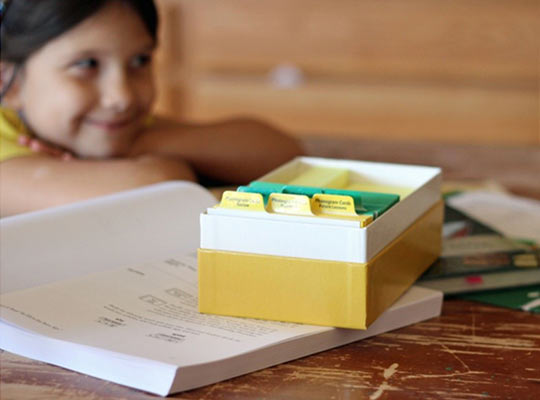
Have you ever wondered what’s involved in a typical day with AAR?
Robin Williams is a real mom who uses All About Reading and All About Spelling with her own kids. Robin is also a part of our Customer Care team. Join Robin as she shares what a typical day with AAR looks like in her homeschool.
Here’s Robin…
Moms often ask what a typical day with AAR is like, and they particularly want to know how other moms divide up a lesson over many days. I’d like to describe what happens in our homeschool and give you a peek inside our lessons.
First, I start by gathering the All About Reading materials and my student.
We start the day’s lesson by reviewing word cards. My daughter is grasping the concepts in All About Reading easily and well, but fluency is coming more slowly for her. Since I don’t move a Word Card to behind the “Mastered” tab until she can read it without sounding it out, she has built up a thick stack of “Review” cards. So I have her read through the stack for two or three minutes, picking up the next day where she left off.
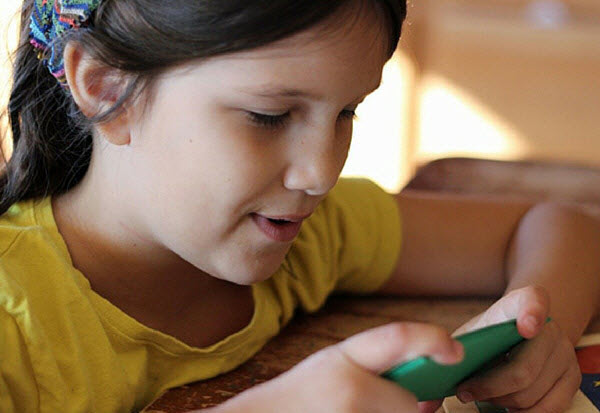
Once a week or so, we review with games. Though the All About Reading Level 1 Ziggy Supplement specifically correlates with All About Reading Level 1, these games will work with cards from any level. So I combine my daughter’s All About Reading review with my older boys’ All About Spelling Level 5 and Level 3 review. In the picture below, they are using a game that requires the players to count syllables in words. In addition to doing the syllable activity, I also required them to read a Phonogram Card before moving the allotted number of spaces. They are all willing to review much longer than usual when they are playing a game!
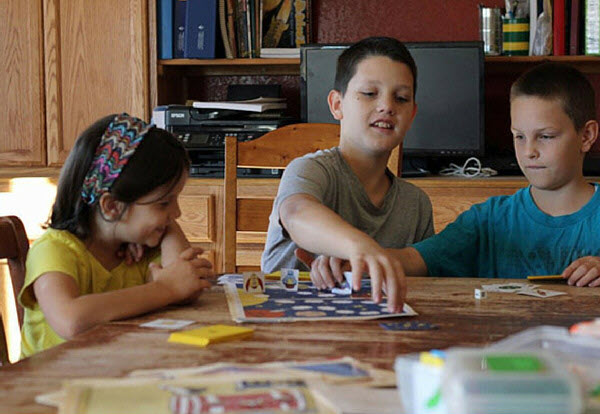
After review, we move onto the New Lesson section in the Teacher’s Manual. Every other lesson begins with new concepts that are introduced with the letter tiles to make the teaching multisensory. I don’t have a lot of wall space in our school/family room, so I hung my magnet board vertically. I use a magnetic chalkboard instead of a white board, mostly because I had one on hand. (I keep my Spelling Strategies and Syllable Types charts for All About Spelling tacked up right next to the magnet board so we won’t lose them!)
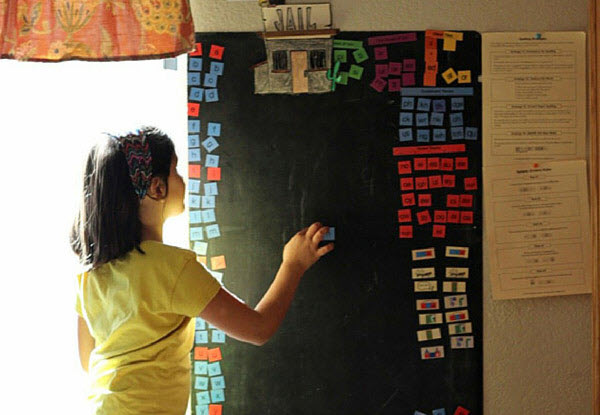
After working with the new concepts, we move on to the fluency practice sheet. Because my daughter struggles with fluency, she really doesn’t enjoy this part of the lesson. I divide most sheets up over at least two days; some of the longer ones we spend as much as four days on. Each day I have her read some of the new words, some of the review words, some of the phrases, and some of the sentences. I allow her to choose which of each to read, and she marks off a row after she has read it.
On the second day of a new concept lesson, after reviewing the cards, we quickly review the concept with the tiles and then move onto the activity sheets. I do not pre-cut the activity sheets because my daughter enjoys cutting them herself. We keep the pieces in an envelope in her pocket folder just in case we want to revisit the activity. We finish this day with more fluency sheet reading.
By the third day of a lesson (or fourth day, if necessary), the lesson’s word cards have been read over at least a couple times and have been shuffled into the stack for more mixed review. We revisit concept teaching with the tiles, mix in game review, and redo activity pages as she slowly works through the fluency practice sheet.
For lessons that have a short story scheduled, we begin the lesson as usual with review of the cards and then we “buddy read” the story. I read a page aloud, slowly but with good expression, and then my daughter reads a page. We continue this way through the story. The following day, after reviewing the cards, we buddy read the story again but switch the pages we read. On the final day of a short story, she reads the entire story herself. By the third time through her reading is usually smoother and much more fluent.
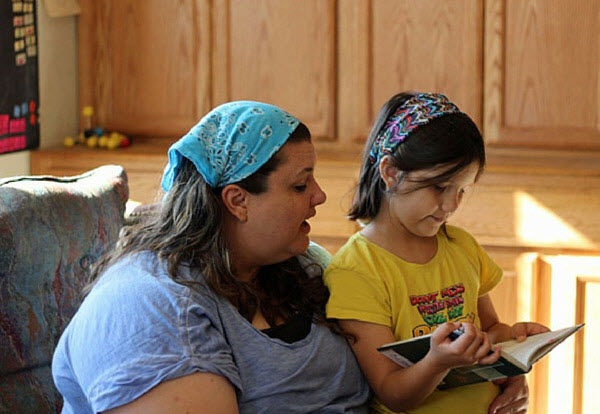
I hope this gives you some idea how a reading lesson can be divided over many days, aiming for about 20 minutes on each day.
Here’s What I Love about Robin’s Story
- Robin’s daughter’s review of the Word Cards is short and brisk, just two to three minutes long.
- Robin adapted a game to make additional review more interesting, and her older children can join in.
- Recognizing the importance of fluency practice, Robin figured out a way to make this portion of the lesson more palatable for her daughter.
- Robin keeps the activity sheet pieces in an envelope so the activities can be reused later.
- I love the buddy reading idea! In fact I loved the idea so much, we asked Robin to share more about it. You can read more about it in this post!
- She sticks to a 20-minute time limit, stopping before her daughter reaches a frustration point. This is important; you want your child to be interested in coming back for more.
Products Robin is using with her daughter
Did you enjoy Robin’s story? Read more stories in our Real Moms, Real Kids series.
What were your main take-aways from Robin’s story? Was this helpful for you?




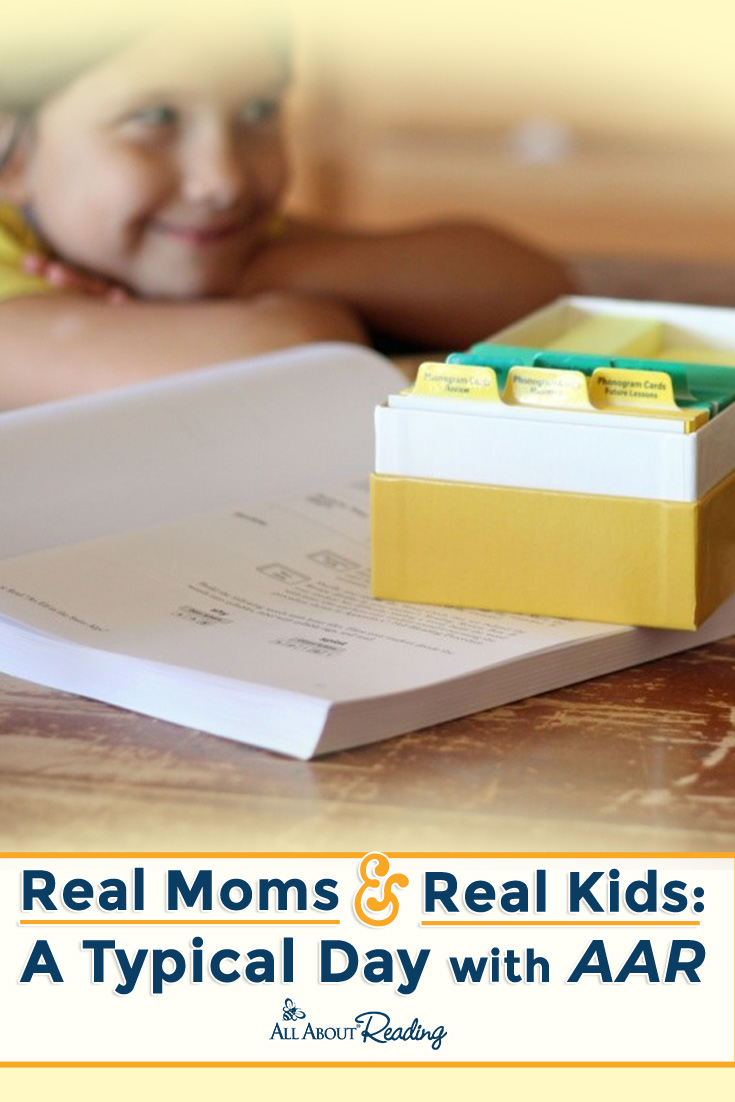





Anna
says:This was an encouraging reminder that I don’t need to have my kids finish 1 lesson per day. I need to set a timer and make sure we aren’t going over 20 mins. Do you recommend starting level 1 in K or first grade?
Robin
says: Customer ServiceAnna,
I’m glad this was encouraging for you!
As for when to start All About Reading Level 1, it depends on the child. Most are reading in kindergarten or first grade, but some are ready sooner and some start Level 1 later. We have a placement test to help you determine what level your child needs.
Melissa
says:This was so helpful thank you!
Robin E.
says: Customer ServiceYou’re welcome, Melissa!
Resa
says:For review, I have my children do the cards behind the review tab as well as a few of the mastered cards each time. If they struggle with a “mastered” card then it gets moved to the review section. This way we are constantly reviewing a mix of cards and do not get overwhelmed with a huge stack of mastered cards a couple of times a level.
At the end of the level, I also move all the cards behind the review tab and we spend 15 minutes a day reading through them. As they read them, the cards get put in order and placed behind the future tab. Any that are a struggle get put back into the review pile. This way, the cards get put in order and are ready for the next kid and the child gets additional practice with the more difficult words.
We do the same thing with All About Spelling.
Robin E.
says: Customer ServiceThank you for sharing how you do review of the mastered cards, Resa! Sounds like a great system to work in fuller ongoing review!
Lani
says:Stopping before the frustration point is so important so kids aren’t anxious or dreading lesson time.
Robin E.
says: Customer ServiceYes, so true, Lani!
Erin
says:I’ve used AAR for three kids (so far). Love it!
Rebecca
says:I love all of these ideas! With my four-year-old, I make the Fluency Sheets more entertaining by having her choose a crayon of her choice (and I choose one too). We each take turns reading words/phrases, and then circle the word we read, or put a check mark beside it. My daughter loves writing on the sheet and the satisfaction of “ticking” the words she reads off!
Robin E.
says: Customer ServiceRebecca,
There is such a wonderful feeling of satisfaction to checking things off! Using that great feeling to help with motivation to read the fluency sheets is a great idea. Thank you for sharing it.
jennifer wagner
says:It is nice to see how others are taking the same curriculum and making it fit for their individual families! Thanks for sharing!
laura cripe
says:I love the giant board for the letter tiles
Brittany
says:It’s so helpful to know how other people are using the curriculum. Thank you!
Robin E.
says: Customer ServiceYou are welcome, Brittany. Since you found this helpful, we have a video showing a teacher and student working through Lesson 3 of AAR 1 that you might also benefit from. It is near the end of our recent How to Teach Reading Comprehension blog post.
Michelle
says:We love All About Reading! Only need Level 4 to complete our set!
Robin E.
says: Customer ServiceCongratulations on nearing the end of All About Reading, Michelle! If you haven’t seen it already, you may find our blog post on What Happens After All About Reading helpful.
Wendy
says:This would be a great tool for my son
Virginia I. Schultz
says:I am excited to apply the ABC Crafts for Uppercase Letters to my granddaughter’s home school curriculum.
Robin E.
says: Customer ServiceVirginia,
We hope you and your granddaughter enjoy the ABC crafts!
Dandi D
says:My son loves reading and this looks like a great program!
Jessica
says:Where would you start a rising fifth grader who has never used the curriculum?
Robin E.
says: Customer ServiceJessica,
We have placement tests for All About Reading to help you decide which level would be best. Also, we recommend having your student read the sample stories from the previous level online as a further confirmation. You want your student to be reading fluently with good comprehension before going to a higher level.
Level 1 sample story
Level 2 sample story
Level 3 sample story
Level 4 sample story
Evaluate (without correcting your student) for the following…
Your student’s ability to decode the words in the story.
Your student’s ability to comprehend the story.
Could your student fluently read the story with expression?
Did your student understand the words from a vocabulary standpoint?
For All About Spelling, we recommend that most students start with level 1 to build a strong foundation in spelling.
For example, we find that many students simply memorize easy words like “cat” and “kid” but have no idea why one uses a C and the other uses a K, or that the same rules that apply to these words also apply to higher level words such as “concentrate.” Other students switch letters or leave out letters entirely. This usually occurs because they don’t know how to hear each sound in the word. Level 1 has specific techniques to solve these problems.
However, we encourage parents and teachers to “fast track” if the student knows how to spell most of the words but does not understand the underlying basic spelling concepts. In this case, very quickly skim the parts that the student already knows and slow down on the parts that he needs to learn. Pull out several words as examples. Make sure he understands the concept being taught, and then move on. This blog article has a good example of how you might fast track.
Please let me know if you have any other questions!
Cheyenne spears
says:As someone who is just starting this program, it is great to see how other people use it for their child!
Robin E.
says: Customer ServiceCheyenne,
This blog post has a video showing Lesson 3 of All About Reading 1 in action. I think you may find it helpful as you begin.
Renatta Welsh
says:It is helpful to see how others use the program. Thanks for sharing!
Melissa
says:We have been using All About Spelling with my now 3rd grader and are on level 3. It has been a great program! Just started level 1 of All About Reading with my K’er. Also a great program! Highly recommend these! They are no-rush programs that can be completely tailored to your child’s pace!
Robin E.
says: Customer ServiceMelissa,
Thank you for sharing how you are using All About Spelling and All About Reading with your children!
Carissa
says:Great blog post!
Judith Martinez
says:It’s so nice to see how other people are using the curriculum. We’re just getting started.
Robin E.
says: Customer ServiceJudith,
This blog post has a video showing Lesson 3 of All About Reading 1 in action. I think you may find it helpful.
Alberta Baxter
says:The program works amazing with children who have dyslexia
Robin E.
says: Customer ServiceAlberta,
Yes, it does! All About Reading and Dyslexia.
Laura
says:I think my son would enjoy this program!
Gabrielle McConeghey
says:I love this. What a great way to get through all the material without the student getting burnt out.
Robin E.
says: Customer ServiceGabrielle,
Yes! While consistent lessons are essential for success, keeping each day’s work short and focused is so important for keeping motivation up. That is why we recommend working on reading for just 20 minutes a day.
Jen S.
says:I love this program. It is great that it is mastery based so my kids can progress at their individual rate.
Robin E.
says: Customer ServiceJen,
Yes! This blog post was from a few years ago, and my daughter finished AAR 4 this winter and she is happily reading all day long! It was difficult for her to become fluent, but she got there and that is what matters.
Eileen
says:This was very helpful. I think I was getting stuck in the idea that “progress” meant “one lesson per day ” or “finishing the program” rather than “mastery” — and my son and I were both getting frustrated. Thank you so much for giving us permission to just …. slow down. I had thought following your plan might draw out the lessons too much and make it seem “boring,” but the opposite has turned out to be true. His favorite part of the lesson? The two minute word card review! He likes to record how many words he read correctly each day, and beat the previous day’s record. He also appreciates not doing the fluency sheet all in one sitting — I have him pick out 3-4 sentences to read ,and circle 2-3 word groups. He’ll do that much of the sheet happily on most days, and it all just works so much better. We also actually set a timer for the lessons, so he knows the end is actually in sight. The improvement in his attitude is doing more to facilitate his progress than anything else. Thank you so much for sharing this!
Robin E. at All About Learning Press
says: Customer ServiceEileen,
I’m so glad to hear how this blog post has helped your son to enjoy reading and make progress! Slow and steady works wonderfully! It’s a year later, and my daughter is now moving through lessons much more quickly, about 2 days for concept lessons and 1 day for story lesson. She is able to do this now, because we took the time to build up her fluency.
Nicole Abrazian
says:Thanks for this article. I will be using this program with my 9 year old and my 5 year old when I start schooling them next month. I was having trouble figuring out how to spread it out over several days. I can’t wait to implement this into their school days.
Robin E. at All About Learning Press
says:Nicole,
You are welcome. The trick is to move at a pace that is comfortable for your student. Some will be comfortable moving through the lessons faster, and some, like my daughter, needs more time.
Let us know if you have any questions or if we can help in any way. I hope you have a GREAT school year!
Sarah L Dupree
says:This was so helpful in making my decision to use All About Reading!
Stacey
says:We just started level 1 with my six year old son. He is loving the program.
Jen R
says:I think my 6yo daughter would love this!
Julie F
says:We have homeschooled for 10 years. I wish I had “All About Learning” when I started. We have used All About Spelling this year and have loved it!
Tonya Ferguson
says:I like this blog